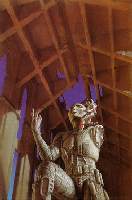



The Robots of Dawn (1983) and the later book Robots and Empire (1985) connect the world of the Asimov's robots novels (The Caves of Steel, The Naked Sun) and short stories (I, Robot etc.) with his Foundation series. The robots in these novels, and the later Foundation series, are the only things keeping humans alive. They insure that humanity stays on the right path for its eventual spread across the galaxy. This goal is aided primarily by the robot Giskard's ability to read and alter human thought. After the events in this novel and its sequel Robots and Empire, robots disappear in Asimov's chronology for thousands of years. The robots reappear again in Foundation and Earth, one of the final Foundation books, where they assist mankind in becoming a "collective galactic mind" to prepare for a coming threat to the galaxy.
 cover art from Foundation and
Earth
cover art from Foundation and
Earth
Plot Summary (Robots of Dawn):
Elijah Baley, the hero from The
Caves of Steel and The Naked
Sun, returns again to solve a case of roboticide on the
distant Spacer (see The Caves of
Steel) planet Aurora in The Robots of Dawn . The robot
victim Jander, who was designed after Baley's robot friend Daneel
Olivaw, has been put in "roblock" and his mind has been erased. The
robot's creator is first suspected as the murderer because he has
political motives. A certain faction among the Spacers believe that
humaniform robots like Jander should precede humans in the
colonization of the Galaxy, and make the new worlds fit for Spacers.
Jander's creator, Fastolfe, does not agree with this approach and is
suspected of killing his robot to prove its fallibility. Baley solves
the murder, absolves Fastolfe, and discovers some profound secrets in
the process.
1.What is the role/function of the robot? Why was
it created?
In this novel the androids are increasingly looked at as
the means for galactic settlement of humanity. Humans are starting to
realize that the only way they can colonize the galaxy is through the
help of robots.
2.How human is it? How human is it meant to
be?
Daneel and his twin (the murdered Jander) are both
humaniform robots which resemble humans in all ways. Jander can even
perform the sexual functions of a human male. The most important
robot in this story, Giskard, is an older non-humaniform robot but
nevertheless has a powerful mind.
3. What is the attitude toward it?
Robots here, as in the other robot novels, are both feared
and revered. They are look upon as the future of humanity, but how
they will accomplish their task is source of conflict.
4. What are the consequences of the robot in this
novel?
In Baley's investigation of the crime he learns that
Gladia Demarre, the wife of the murdered roboticist in
The Naked Sun, had used Jander for
his sexual functions and even looked at him as a lover and husband.
The consequence of a humaniform and obedient robot, in this instance,
is that he becomes the perfect mate. Another important consequnce of
robots in this novel is the android Giskard. Giskard has a terrible
secret: he can read and manipulate human emotions. With his ability
he discovers that one of Fastolfe's rivals was trying to use Jander
to further his motives of galactic pre-colonization by robots.
Giskard must kill Jander in order to protect Fastolfe. He also allows
Fastolfe to be accused so Baley will come to Aurora, and Giskard can
study Baley to see if Earthmen are fit and willing to eventually
colonize the Galaxy, which Giskard believes is the inevitable and
right path for humanity.
5. Conclusion:
The idea of a robot as a lover was new to Asimov's robot
novels. Also, the idea of an android that can read human thoughts was
new to his novels, and rare in science fiction. It is interesting,
and presumbly desirable, that the first being with the abililty to
read and control human thoughts is a robot. Fortunately, Giskard is a
classic Asimov robot--a robot with seemingly only humanity's
protection as its motive.